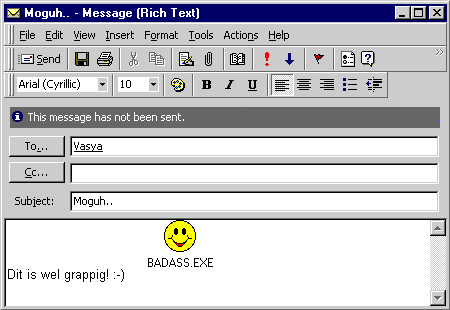Parent class: VirWare
Viruses and worms are malicious programs that self-replicate on computers or via computer networks without the user being aware; each subsequent copy of such malicious programs is also able to self-replicate. Malicious programs which spread via networks or infect remote machines when commanded to do so by the “owner” (e.g. Backdoors) or programs that create multiple copies that are unable to self-replicate are not part of the Viruses and Worms subclass. The main characteristic used to determine whether or not a program is classified as a separate behaviour within the Viruses and Worms subclass is how the program propagates (i.e. how the malicious program spreads copies of itself via local or network resources.) Most known worms are spread as files sent as email attachments, via a link to a web or FTP resource, via a link sent in an ICQ or IRC message, via P2P file sharing networks etc. Some worms spread as network packets; these directly penetrate the computer memory, and the worm code is then activated. Worms use the following techniques to penetrate remote computers and launch copies of themselves: social engineering (for example, an email message suggesting the user opens an attached file), exploiting network configuration errors (such as copying to a fully accessible disk), and exploiting loopholes in operating system and application security. Viruses can be divided in accordance with the method used to infect a computer:- file viruses
- boot sector viruses
- macro viruses
- script viruses
Class: Email-Worm
Email-Worms spread via email. The worm sends a copy of itself as an attachment to an email message or a link to its file on a network resource (e.g. a URL to an infected file on a compromised website or a hacker-owned website). In the first case, the worm code activates when the infected attachment is opened (launched). In the second case, the code is activated when the link to the infected file is opened. In both case, the result is the same: the worm code is activated. Email-Worms use a range of methods to send infected emails. The most common are: using a direct connection to a SMTP server using the email directory built into the worm’s code using MS Outlook services using Windows MAPI functions. Email-Worms use a number of different sources to find email addresses to which infected emails will be sent: the address book in MS Outlook a WAB address database .txt files stored on the hard drive: the worm can identify which strings in text files are email addresses emails in the inbox (some Email-Worms even “reply” to emails found in the inbox) Many Email-Worms use more than one of the sources listed above. There are also other sources of email addresses, such as address books associated with web-based email services.Read more
Platform: Win32
Win32 is an API on Windows NT-based operating systems (Windows XP, Windows 7, etc.) that supports execution of 32-bit applications. One of the most widespread programming platforms in the world.Description
Technical Details
This is a virus-worm that spreads via the Internet using MS Outlook. The worm itself is a Windows EXE file about 25Kb in length, and written in VisualBasic. The worm seems to be based on the "Melissa" macro-virus worm - the functions and sequence of instructions in the worm code are very similar to the "Melissa" source code. It seems that this worm was compiled from a slightly modified "Melissa" source.
The worm is transferred via the net in e-mail messages with an infected attachment. The original attachment has the BADASS.EXE name, but it is possible to rename the EXE file manually, and it then will spread with a new name.
When an infected message is received and the attached EXE file is executed, the worm gains control and starts its main routine. This routine displays message boxes, then run the infection routine that opens the Outlook database, obtains e-mail addresses from the Address Book and sends infected messages to the addresses found. The subject in the infected messages contains the text "Moguh.." and the message text is "Dit is wel grappig! :-)".

The worm does not send messages twice from the same computer. To avoid duplicate spreading, the worm creates a system registry key, and checks it upon each start:
HKCUSoftWareVB and VBA Program SeettingsWindowsCurrentVersion "CMCTL32"="00 00 00 01" [Adult only--------------------------------------------------]
The first message box displayed by the worm appears as follows:
Kernel32 An error has occured probably because your c**t smells bad. Is this really so? [ Yes ] [ No ]
Upon the mouse cursor moving to the [No] button, the worm moves this button another place to the left [Yes], and return it back when the mouse cursor moves near to button, and so on until clicking [Yes]:
[ Yes ] [ No ] [ No ] [ Yes ] [ Yes ] [ No ]
So the worm does not allow one to click the [No] button. When the [Yes] button is pressed, the worm displays another message and runs its infection routine:
WIN32 Contact your local supermarket for toiletpaper and soap to solve this problem. [ OK ]
Read more
Find out the statistics of the vulnerabilities spreading in your region on statistics.securelist.com